Every trail in Ontario’s parks weaves together two distinct yet intertwined narratives: documented history carved in stone and soil, and enchanting legends passed down through generations. From the ancient pictographs of Petroglyphs Provincial Park to the whispered tales of spirit lights dancing over Lake Superior, these stories transform ordinary landscapes into powerful connections to our past. Experience living history through guided interpretive walks, where passionate naturalists reveal how Indigenous peoples and early settlers shaped these lands. Listen closely to the rustling leaves of thousand-year-old cedars in Killarney, each one harboring secrets of fur traders and prospectors who once sought fortune beneath their branches. Whether you’re tracking the historical footprints of logger camps in Algonquin or chasing the legendary Manitou spirits of Georgian Bay, these parks preserve not just wilderness, but the very essence of Ontario’s rich cultural tapestry. Pack your curiosity alongside your hiking boots – you’re about to discover how every rock, river, and ravine tells a story waiting to be uncovered.
Indigenous Heritage and Sacred Sites
Ancient Meeting Grounds
Long before the establishment of Ontario’s provincial parks, these lands served as vital meeting grounds for Indigenous peoples. Many of today’s most popular park locations were once traditional gathering places where different nations would come together to trade, celebrate, and share stories.
At Petroglyphs Provincial Park, ancient rock carvings tell stories of gatherings that took place hundreds of years ago. The Teaching Rocks, as they’re known to the Anishinaabe people, contain over 900 symbolic carvings depicting ceremonies, animals, and spiritual teachings. To this day, these sacred sites continue to hold deep cultural significance.
Bon Echo Provincial Park’s iconic Mazinaw Rock was another significant meeting place. The towering cliff face, rising 100 meters above Mazinaw Lake, features over 260 Indigenous pictographs – the largest collection of such rock paintings in southern Ontario. Local elders share stories of how their ancestors would gather here during seasonal migrations, using the rock face as a natural landmark.
These traditional meeting grounds remain places of connection today. Many parks offer Indigenous programming where visitors can learn about these gathering places from Knowledge Keepers. Through guided walks and interpretive programs, you can discover the rich history of these lands while developing a deeper appreciation for their ongoing cultural importance.
Remember to approach these sites with respect, understanding that they’re not just historical landmarks but living cultural spaces that continue to hold meaning for Indigenous communities today.
Sacred Landmarks
Throughout Ontario’s parks, sacred landmarks tell stories of indigenous peoples who have lived on these lands for thousands of years. Petroglyphs Provincial Park, home to the largest known concentration of Indigenous rock carvings in Canada, stands as a testament to this rich heritage. These ancient rock carvings, depicting turtles, snakes, birds, and human figures, are considered sacred by the Anishinaabe peoples who call them “The Teaching Rocks.”
In Bon Echo Provincial Park, the massive Mazinaw Rock rises 100 meters above Mazinaw Lake, its face adorned with over 260 pictographs in red ochre. These mysterious images, some dating back over a thousand years, continue to captivate visitors and scholars alike. Local Indigenous guides often share the spiritual significance of these sites during interpretive programs, offering visitors a deeper understanding of their cultural importance.
Other significant spiritual sites include the Spirit Sands in Awenda Provincial Park and the Medicine Wheel Trail in Lake Superior Provincial Park. These locations remain active ceremonial grounds for Indigenous communities, reminding us of the ongoing spiritual connection between the land and its first peoples.
When visiting these sacred landmarks, remember to show respect by observing without touching, staying on marked trails, and participating in guided tours when available. These ancient sites aren’t just historical artifacts – they’re living connections to traditions that continue to this day.
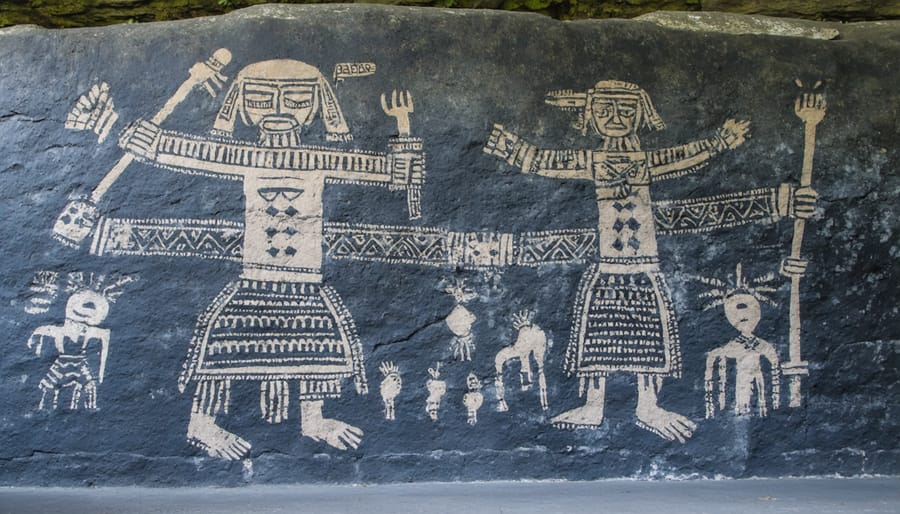
Pioneer Tales and Settlement History
Ghost Towns Within Park Borders
Within Ontario’s parks lie the haunting remnants of once-thriving communities, each telling a unique story of pioneer life and eventual abandonment. These ghost towns, perfect for nighttime adventures, offer visitors a fascinating glimpse into Ontario’s past.
One of the most intriguing is Balaclava, nestled in Bon Echo Provincial Park. Once a bustling lumber mill town in the late 1800s, it now stands as a collection of weathered buildings and old mill foundations. Visitors can still spot the massive wheel that once powered the sawmill, now peacefully rusting among the growing forest.
In Algonquin Park, the ghost town of Mowat tells the tale of a logging community that flourished in the early 1900s. Today, careful observers can find scattered brick foundations and the occasional piece of logging equipment along the hiking trails, while interpretive panels help bring the story to life.
Perhaps the most mysterious is the settlement of Depot Creek in Frontenac Park. This former mining community vanished so completely that only a few stone foundations remain, though local legends speak of prospectors who still roam the area in search of forgotten mineral deposits.
These abandoned settlements serve as powerful reminders of our relationship with the land and the cyclical nature of human endeavors. Park visitors are encouraged to respect these historical sites and take only photographs, leaving these fascinating time capsules intact for future generations to discover.
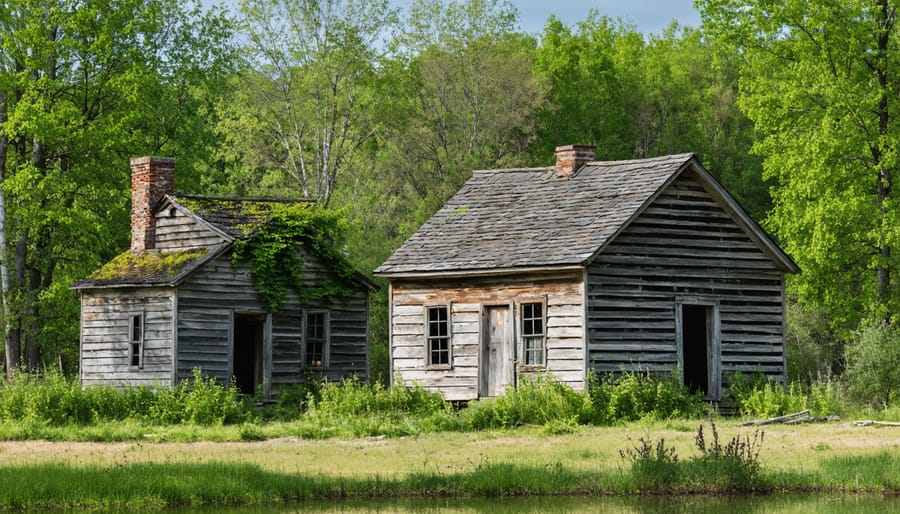
Logging and Mining Legacy
The rugged landscapes of Ontario’s parks tell a compelling story of the province’s logging and mining heritage. In the late 1800s and early 1900s, these pristine wilderness areas were bustling with activity as logging camps and mining operations dotted the landscape. Many of today’s hiking trails follow the same paths that lumber workers once used to transport massive white pine logs to nearby rivers.
At night, visitors might hear echoes of the past as nocturnal park residents create sounds reminiscent of old logging camp activities. Local legend tells of phantom loggers still calling out in the mist, their voices carried on evening breezes.
The transformation from resource extraction to conservation wasn’t always smooth. When the logging industry declined, many communities faced economic challenges. However, this transition ultimately led to the establishment of our beloved park system. Today, you can still spot evidence of this industrial past – abandoned mine shafts (now safely sealed), old logging dams, and the occasional rusty equipment slowly being reclaimed by nature.
Several parks offer interpretive programs where visitors can explore restored logging camps and learn about the tough lives of early settlers. These programs help us appreciate how our parks evolved from industrial sites to the natural sanctuaries we cherish today.
Haunted Trails and Mysterious Phenomena
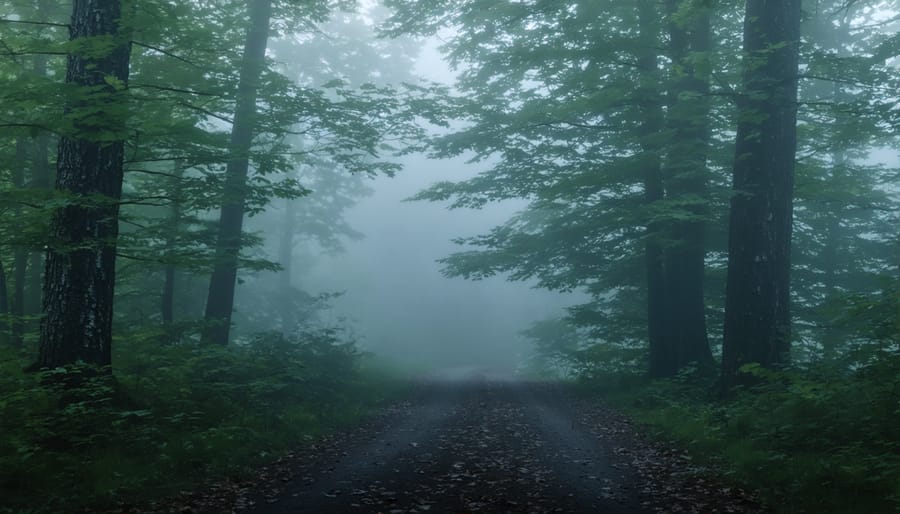
Campfire Stories
As the sun sets and darkness falls over Ontario’s parks, seasoned campers gather around crackling fires to share tales that have echoed through these forests for generations. One of the most famous stories is that of the Wendigo, a terrifying spirit of the northern woods that local Indigenous peoples say stalks those who succumb to greed and desperation during harsh winters.
Along the shores of Lake Superior, campers whisper about the Ghost Ship of Silver Islet, a phantom vessel that appears during storms, said to be the remnant of a 19th-century mining disaster. In Algonquin Park, visitors speak of the White Canoe, a spectral craft paddled by the spirit of a young artist who disappeared mysteriously in 1917.
Bon Echo Provincial Park holds perhaps the most haunting tale of all – the Legend of Nanabozho, whose image is said to be carved into the massive cliff face overlooking Mazinaw Lake. On quiet nights, some claim to hear ancient drum beats echoing across the water.
For the full experience, join the evening programs offered by park naturalists during summer months. These gatherings around the campfire not only share these spine-tingling tales but also reveal the historical truths and cultural significance behind many of our cherished park legends. Remember to bring a flashlight – and maybe a brave friend!
Ranger Reports
Over the years, park rangers have documented numerous unexplained phenomena and mysterious encounters that add to the rich tapestry of Ontario Parks’ folklore. While patrolling historical hiking trails, several rangers have reported hearing distant drums and singing, particularly during full moons, though no groups were camping in the area.
In Algonquin Park, multiple staff members have described encounters with what they call the “Mist Walker” – a tall, ethereal figure that appears in early morning fog and vanishes when approached. Rangers working night shifts have documented strange lights dancing above the treeline, reminiscent of the stories told by Indigenous peoples about spirit fires.
One particularly intriguing account comes from a senior park naturalist who, while conducting a winter wildlife survey, discovered perfectly preserved footprints in the snow that didn’t match any known species. The prints mysteriously ended at a rock face, with no continuation or return tracks visible.
More recently, rangers have reported curious incidents of items in locked buildings being rearranged overnight, and campfire circles being found neatly maintained in remote areas where no camping is permitted. While these occurrences might have logical explanations, they continue to fuel the imagination and add to the mystique of Ontario’s wilderness areas.
Historical Tours and Programs
Guided Experiences
Step into the past with our engaging ranger-led programs that bring Ontario Parks’ rich history to life. Every summer evening, gather around crackling campfires as seasoned park interpreters share captivating tales of Indigenous peoples, early settlers, and legendary park characters. These storytelling sessions often feature authentic artifacts and historical photographs that help visitors connect with the park’s fascinating past.
For history enthusiasts, specialized historical tours offer deep dives into specific aspects of park heritage. At Algonquin Park, join the “Logging Legacy Tour” to explore remnants of 19th-century lumber camps and discover how the logging industry shaped the region. In Wasaga Beach Provincial Park, the “Nancy Island Historic Site Tour” reveals the dramatic story of a War of 1812 shipwreck and its impact on Canadian history.
Insider tip: Book these popular programs early in your stay – they often fill up quickly, especially during peak season. Many parks also offer kid-friendly historical programs where young visitors can try traditional crafts or participate in historical reenactments.
For a self-guided experience, pick up a Heritage Tour booklet from your park’s visitor center. These detailed guides include historical photographs, maps, and fascinating facts about significant sites within the park. Remember to bring comfortable walking shoes and your camera – you’ll want to document these glimpses into Ontario’s past.
Self-Guided Adventures
Ontario’s parks offer numerous self-guided opportunities to explore the rich tapestry of history and legends at your own pace. Many trails feature interpretive panels that bring the past to life, allowing you to step back in time while enjoying the natural surroundings.
The Heritage Education Centre at Algonquin Provincial Park serves as an excellent starting point for history enthusiasts. Here, you’ll find detailed exhibits chronicling the park’s logging history, Indigenous heritage, and the evolution of park recreation over the past century.
Don’t miss the Petroglyph Provincial Park’s Learning Place, where you can discover the largest known concentration of Indigenous rock carvings in Ontario. The self-guided tour provides fascinating insights into Indigenous spirituality and culture, with over 900 prehistoric carvings to explore.
For maritime history buffs, Fathom Five National Marine Park’s visitor center offers interactive displays about shipwrecks and early Great Lakes navigation. Follow the shoreline trails to discover viewing platforms overlooking historic lighthouses and shipwreck sites.
Insider tip: Download park-specific apps before your visit, as many offer audio tours and augmented reality features that enhance the self-guided experience. The best times for these adventures are during early morning or late afternoon when the trails are less crowded and the lighting is perfect for photography.
Remember to bring a journal to document your discoveries and respect any historical artifacts or sites you encounter. Many visitors find that these self-guided experiences allow for deeper connection with Ontario’s fascinating past.
The stories and legends of Ontario’s parks are more than just entertaining tales – they’re vital threads in the fabric of our province’s heritage. By preserving and sharing these narratives, we keep alive the rich cultural traditions of Indigenous peoples, early settlers, and all those who have called these lands home. These stories help us understand our connection to the landscape and remind us of our responsibility to protect these natural spaces for future generations.
To experience these historical treasures firsthand, consider participating in park interpreter programs, which often include guided walks and evening storytelling sessions. Many parks offer specialized history programs during summer months and on significant holidays. For the best experience, book these programs in advance, especially during peak season.
Pro tip: Pick up a park’s trail guide or historical pamphlet at the visitor center before setting out. These often contain historical points of interest and legendary tales you can explore at your own pace. Consider visiting during shoulder seasons (spring and fall) when smaller crowds allow for more intimate experiences with historical sites.
Remember to approach sacred and historical sites with respect. Take only photos, leave only footprints, and help preserve these special places so their stories can continue to inspire and educate visitors for generations to come. By understanding our past, we can better appreciate our present and work toward a more sustainable future for our beloved parks.

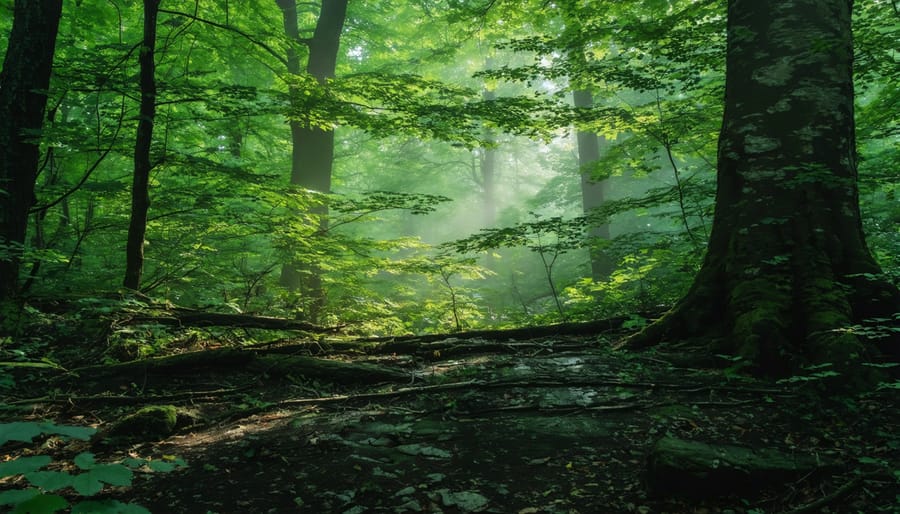
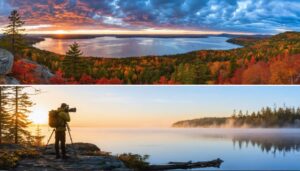



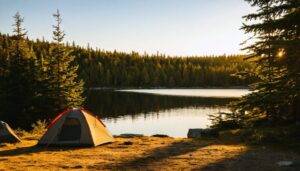
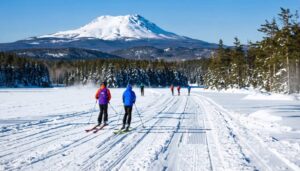
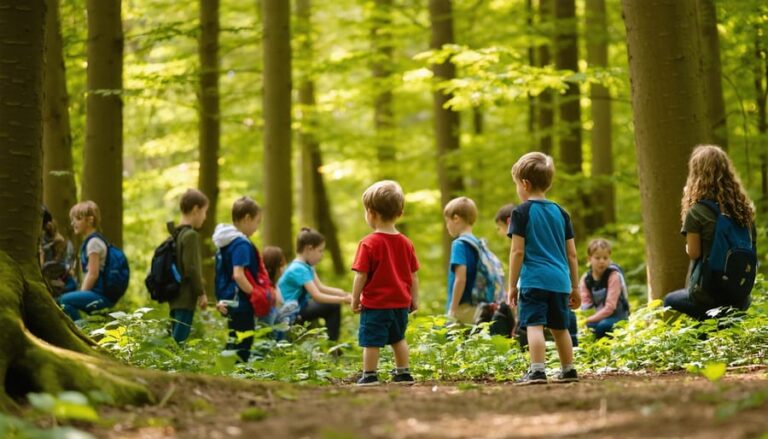
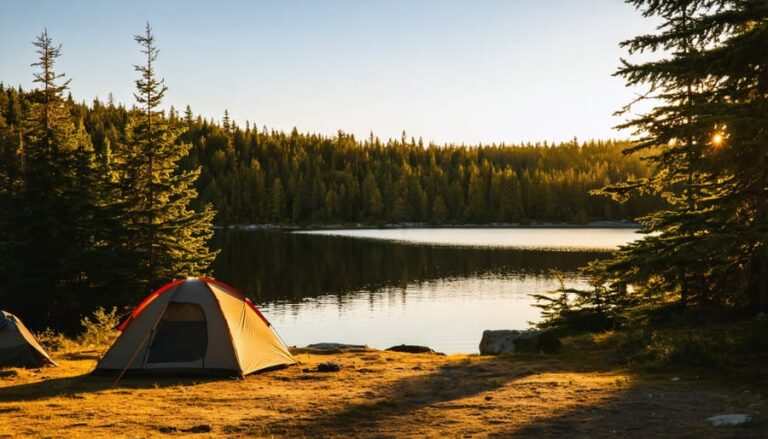
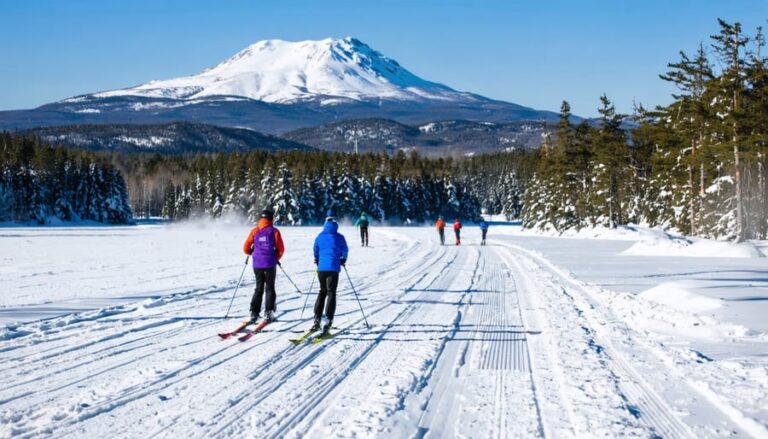

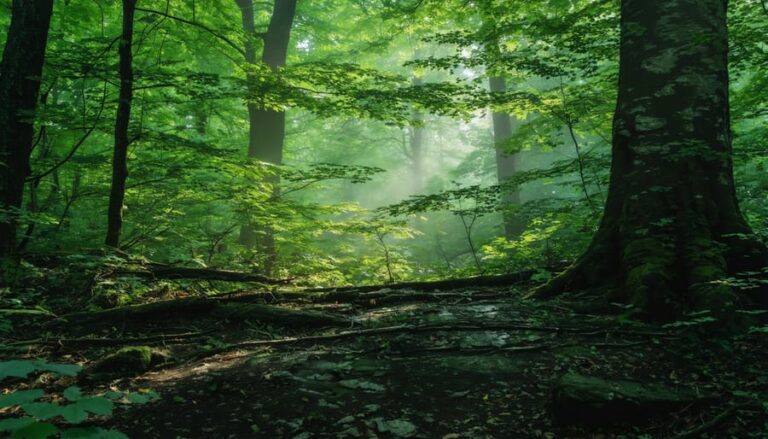
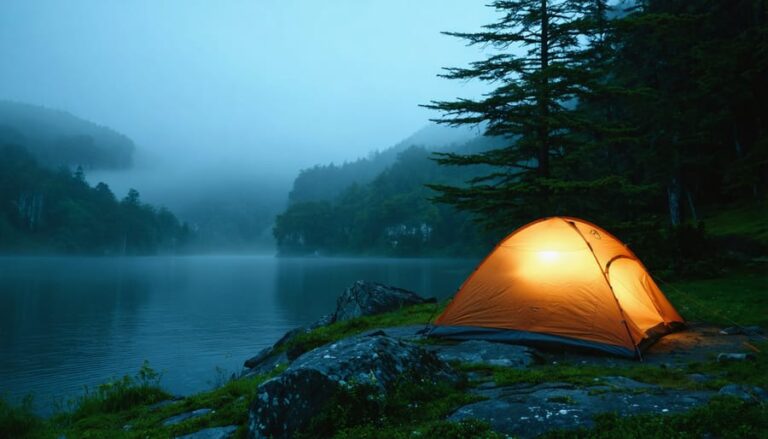
+ There are no comments
Add yours